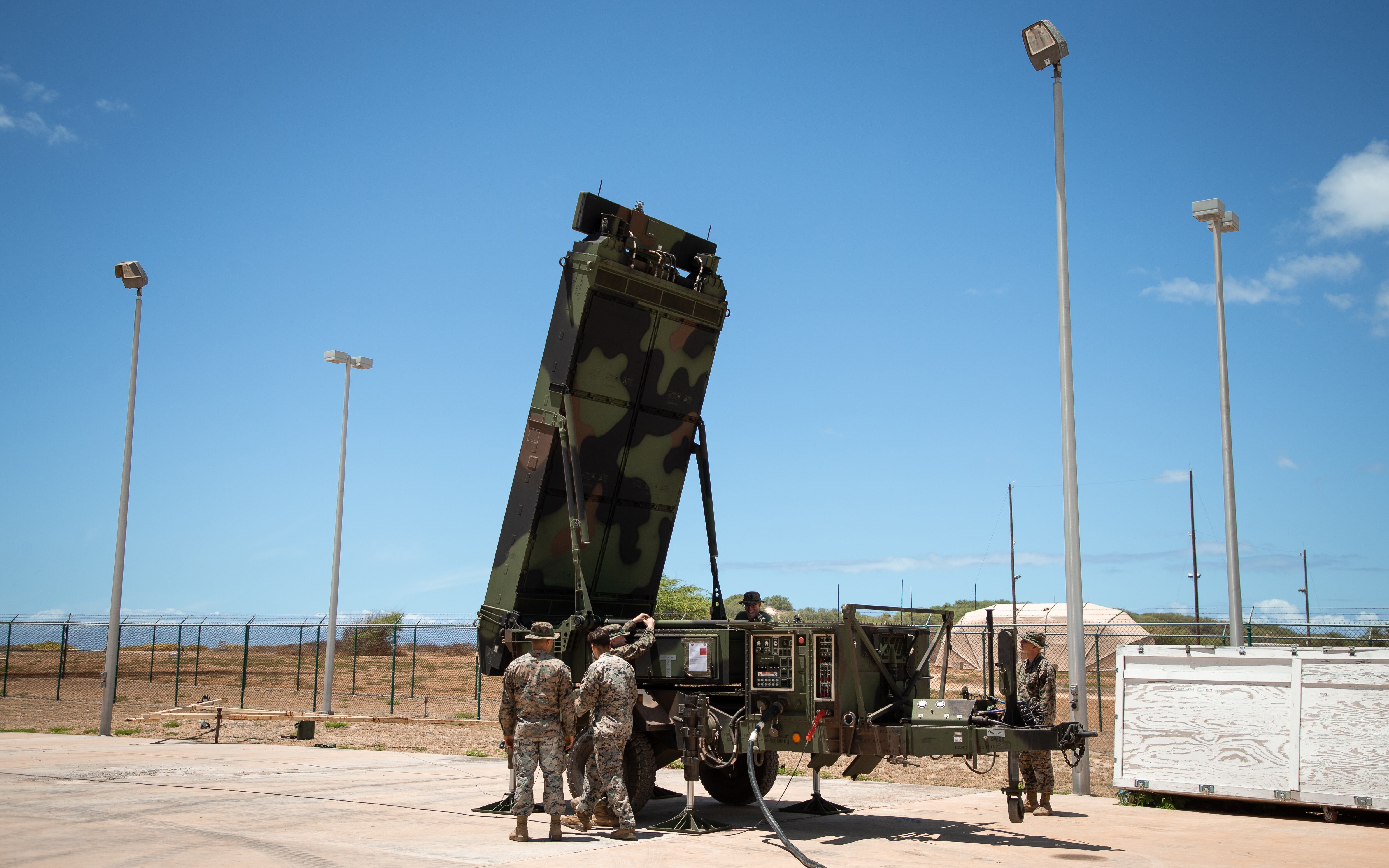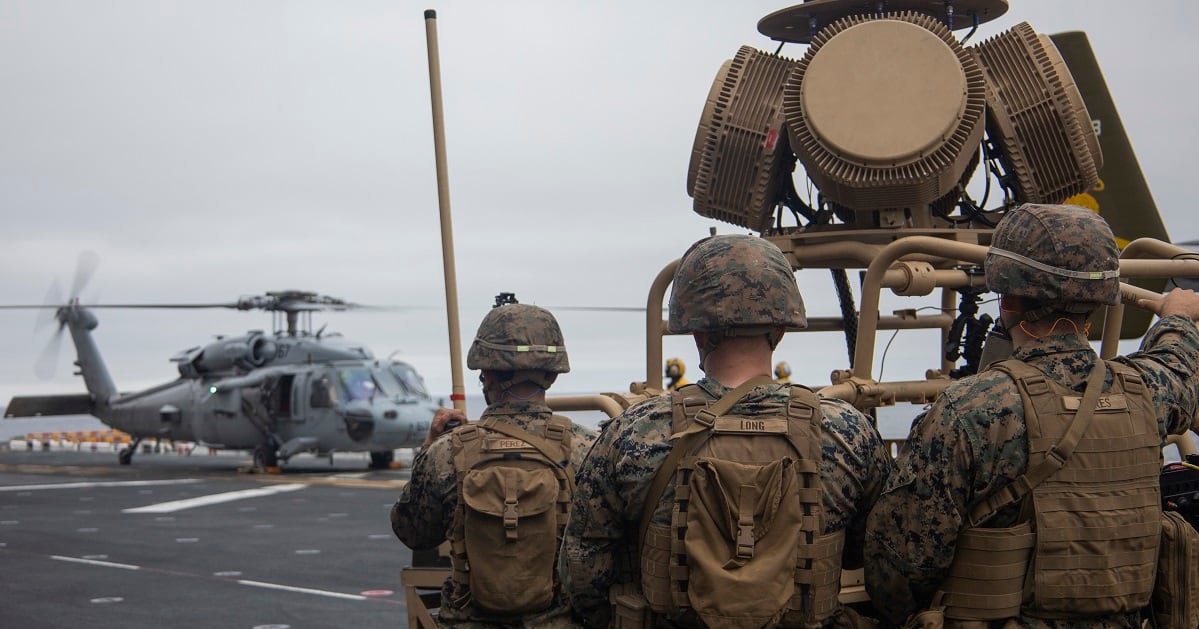By fall 2024, Marine Corps low altitude air defense battalions will begin receiving a powerful new weapon: Marine air defense integrated systems, or L-MADIS, a vehicle-mounted powerhouse that can detect and shoot down hostile drones or even low-flying helicopters and fixed-wing aircraft.
Inside the 2024 budget request is more than $200 million to purchase the systems and fund upgrades to make them even more formidable against aerial targets.
The operational debut of MADIS came in July 2019, when its light version, or L-MADIS, mounted on a variant of the Polaris MRZR all-terrain vehicle shot down an Iranian drone while deployed aboard the amphibious assault ship Boxer.
The mission, which came about a month after Iran downed an expensive U.S. Air Force RQ-4 Global Hawk, showcased the transportability and effectiveness of the MADIS family of systems.
RELATED

With air defense identified as a focus area in Marine Corps Commandant Gen. David Berger’s Force Design 2030, and the MADIS family of systems specifically called out as a priority, the Marine Corps is substantially ready to invest in the technology.
The requested funding for fiscal 2024 will include $130.2 million, or about $10 million apiece, to buy 13 MADIS Increment 1 systems, to be mounted on top of joint light tactical vehicles; $24.6 million to retrofit seven previously procured systems with existing technology; and another $12.5 million for training and logistics.
Another $8 million is dedicated to procuring engineering change orders “required to ensure increased lethality against evolving threats,” according to a budget justification document.
The document adds that the MADIS Increment 1 Block 2 upgrade, which will start the acquisition process by fall, “will focus on kinetic and non-kinetic capability supporting increased lethality.”
In 2022, the Marine Corps held an industry day focused on the same goal: building capabilities into the next version of MADIS that will enable it to be lethal against more, and larger, drones.
Program Manager Ground-Based Air Defense “intends to acquire solutions from vendors that are capable of providing a Group 1 and 2, with potential for 3, (counter-unmanned aerial system) defeat capability via an effector,” an event notice stated. “The effector would increase the range of C-UAS defeat capability to augment the current defeat mechanisms.”
As defined by the U.S. military, Group 1 and 2 unmanned aerial systems weigh up to 55 pounds, operate at altitudes up to 3,500 feet, and travel at speeds of 100 miles per hours or more. Group 1 unmanned aerial systems include the hand-launched and remote-controlled RQ-11 surveillance drone, for example; Group 2 includes the catapult-launched, long endurance ScanEagle.
Group 3 is an order of magnitude greater in size and capability; it includes drones weighing up to 1,320 pounds and capable of operating at 18,000 feet of altitude and at nearly 300 miles per hour. One Group 3 platform is the Aerovironment T-20, a catapult-launched drone that can stay airborne for up to 24 hours.
Making MADIS effective against a greater range of unmanned aircraft would make it more formidable and more versatile, particularly in a deployed environment.
A request for proposals “will be released prior to the end of the current fiscal year for the MADIS Block 2 effort that will be seeking industry solutions to meet a full range of defeat technologies to counter the UAS threat,” Barbara Hamby, a spokeswoman for Program Executive Office Land Systems, told Marine Corps Times in an email.
The Block 1 JLTV-mounted MADIS system comes in two variants. Mk1, for airborne threats, includes turret-launched and shoulder-fired Stinger missiles for mounted and dismounted ops, multifunctional electronic warfare capability and an electro-optical infrared optic. The MK2, specialized for drone-killing, includes multi-functional electronic warfare, 360-degree radar, and a command-and-control communications suite.
“The high-powered tactical and electronic technologies of MADIS Inc 1.0 gives indispensable advantages to low altitude air defense battalions conducting fire and maneuver missions within the weapons engagement zone,” Hamby said. “The MADIS Mk1 and Mk2 form a complementary pair and will be the basic building block of the LAAD Battalions’ ground-based air defense capability.”
L-MADIS, which is small enough to be transported in a sling below an H-53 helicopter, also comes as a two-vehicle set. The Mk-1 variant can transmit and receive data from air and ground platforms, while the Mk-2 adds target detection, tracking, and friend-or-foe identification, according to budget documents.
Easily deployable aboard ships, these systems will provide an added layer of defense for Marine expeditionary units at sea.
The 2024 budget request includes $32.5 million for L-MADIS procurement, including $23 million for five L-MADIS systems and the remainder for logistics, labor and training.
Prior to fielding, several MADIS and L-MADIS systems already are operating in the fleet.
An L-MADIS vehicle deployed aboard the amphibious assault ship Bataan with the 26th Marine Expeditionary Unit is currently the only counter-unmanned aerial system on the East Coast organic to the Marine Corps, according to releases. In January, the system was secured on the flight deck to track a simulated adversary vessel in the Atlantic.
In November 2022, the Marine Corps activated Charlie Battery, 3rd Low Altitude Air Defense Battalion, out of Camp Pendleton, California, underscoring the substantial role ground-based air defense will play in the ongoing force modernization effort amid greater ubiquity and variety of threats from above.
The battery’s core equipment will include MADIS, as well as Stinger missiles to neutralize the airborne threats it detects.
The new and soon-to-be-equipped unit represented “is another piece to the pie of modernizing the force to meet future threats,” Maj. Crispus M. Kimani, operations officer for 3rd Low Altitude Air Defense battalions Battalion, said in a release.





